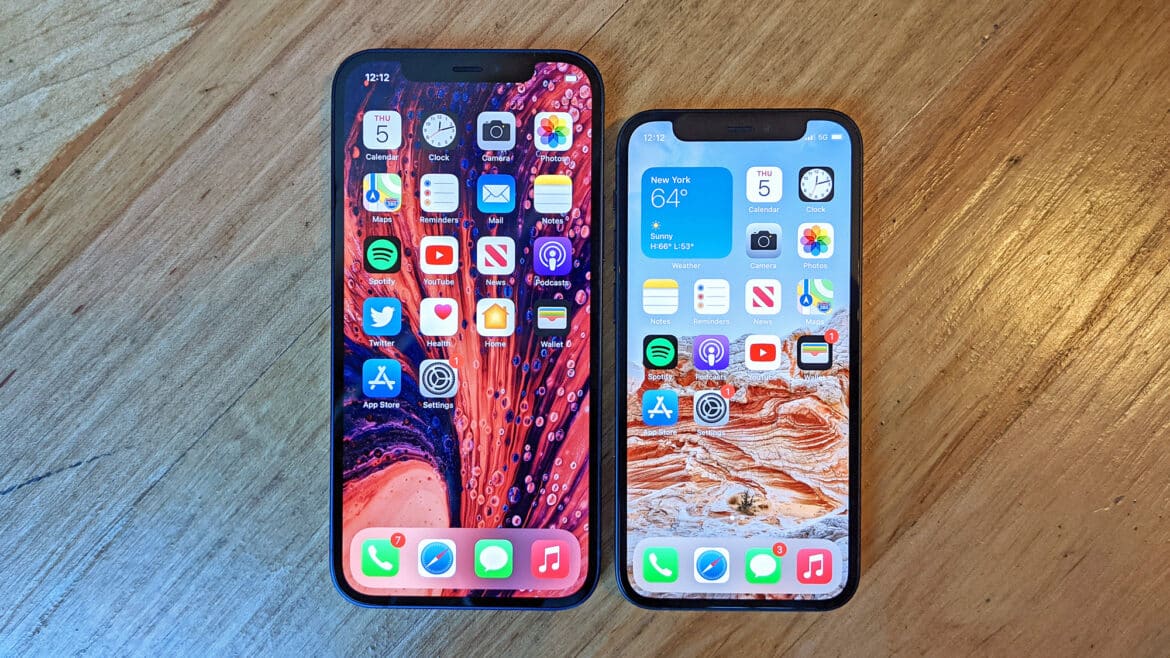345
One of the differences between the iPhone 12 and iPhone 12 mini is obvious at first glance: the size. But there are other differences—and numerous similarities.
iPhone 12 and iPhone 12 mini – the differences in detail
Although the iPhone 12 and iPhone 12 mini appear almost identical at first glance, they differ in several key respects. Size, battery life, and price in particular play an important role in the purchase decision.
- Size and weight: The iPhone 12 measures 146.7 × 71.5 × 7.4 mm and weighs 162 g. The iPhone 12 mini is significantly more compact at 131.5 × 64.2 × 7.4 mm and weighs only 133 g. This makes the mini model particularly suitable for users who prefer a handy smartphone.
- Display and resolution: Both models have an OLED display, but differ in terms of diagonal size: iPhone 12 mini: 5.4 inches, 2340 × 1080 pixels, 476 ppi and iPhone 12: 6.1 inches, 2532 × 1170 pixels, 460 ppi.
- In practice, the difference in image sharpness is barely noticeable. Both support HDR10 and Dolby Vision, achieve a peak brightness of up to 1200 nits, and offer a refresh rate of 60 Hz. Thanks to OLED technology, both devices impress with vibrant colors, deep blacks, and high contrast.
- Battery life and charging behavior: The iPhone 12 mini has a battery with a capacity of around 2,227 mAh, while the iPhone 12 has around 2,815 mAh. According to Apple, the iPhone 12 mini’s battery lasts for up to 15 hours of video playback, while the iPhone 12 lasts for up to 17 hours. Both models support fast charging via Lightning with up to 20 watts (approx. 50% in 30 minutes), wireless charging via MagSafe with up to 15 watts (iPhone 12 mini: up to 12 watts), and Qi charging with up to 7.5 watts.
- In everyday use (surfing, messaging, streaming), both devices achieve a solid battery life for one day – however, the Mini may need to be recharged a little earlier with intensive use. Due to its smaller design, the Mini also gets slightly warmer under load.
- Price (as of 2025): Both models are now only available sporadically in stores. Used or refurbished, prices currently range from around $350 (Mini, 64 GB) to $500 (iPhone 12, 256 GB), depending on condition and storage capacity.
iPhone 12 and iPhone 12 mini – Common features
Despite the differences in size and battery performance, the iPhone 12 and iPhone 12 mini share the same technical basis in many respects. This makes both models almost equivalent in terms of performance and camera quality.
- Camera: Both the iPhone 12 and iPhone 12 mini have an identical dual camera system: 12 MP wide angle (f/1.6) and 12 MP ultra wide angle (f/2.4, 120° field of view). Both offer optical image stabilization, Smart HDR 3, Night Mode, Deep Fusion, and 4K video recording at up to 60 fps. The 12 MP front camera also supports Night Mode and 4K video recording.
- Processor and performance: Both devices are powered by the 6-core Apple A14 Bionic chip. It will continue to deliver strong everyday and gaming performance well into 2025. The 12 series is still well positioned for iOS updates – support is likely to continue until at least iOS 19.
- Mobile communications and connectivity: Both devices support 5G, LTE, Wi-Fi 6, Bluetooth 5.0, GPS, and NFC (Apple Pay). A physical SIM and an eSIM can be combined (dual SIM function).
- Colors and protection class: Both devices were available in black, white, green, blue, (PRODUCT)RED, and later in purple. The protection class IP68 stands for dust resistance and water protection up to a depth of 6 meters for 30 minutes.
Everyday usability and user experience of the two iPhone models
In addition to the pure technical data, practical everyday use also plays a decisive role. This is where the advantages and disadvantages of the two models become particularly clear.
- The iPhone 12 mini is perfect for anyone looking for a powerful but handy smartphone. It can be operated with one hand and fits easily into any pocket. The disadvantage is the battery life – it is slightly shorter than larger models, especially with intensive use (navigation, video conferencing, games).
- The iPhone 12 offers more display space and a slightly longer battery life, making it better suited for multimedia, gaming, and heavy users. Both models benefit from high-quality workmanship, MagSafe accessory compatibility, and system performance that is still very smooth.
- Despite their age (launched in 2020), both devices are still suitable for everyday use and continue to receive iOS updates. The iPhone 12 mini scores with its compactness, while the iPhone 12 offers slightly more comfort and battery life.
- If you’re looking for a small, lightweight, yet powerful iPhone, you’ll be happy with the Mini. If, on the other hand, you prefer more endurance and screen space, you should go for the iPhone 12. In terms of price, both are now attractive options in the mid-range segment.

